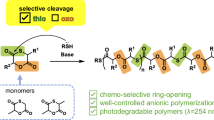Summary
The cationic polymerization of 3,3-diethyloxetane leads to a mixture of polymer and cyclic oligomers. The cyclic tetramer is the most important oligomer and is formed in 20–35% yield. This behaviour is almost identical to that of the unsubstituted oxetane and 3,3-dimethyloxetane. The monomer consumption shows two distinct stages: a very fast stage is followed by a slow stage, leading to complete conversion. The cyclic oligomers are formed only during the second stage.
Similar content being viewed by others
References
BLACK, P.E. and WORSFOLD, D.J.: Can. J. Chem. 54, 3325 (1976)
BUCQUOYE, M.R. and GOETHALS, E.J.: Makromolek. Chem. 179, 1681 (1978)
DREYFUSS, P. and DREYFUSS, M.P.: Polym. J. 8, 81 (1976)
ROSE, J.B.: J. Chem. Soc. 1956, 542; ibid. 1956, 546
VAN GAEVER, et al.: Org. Mass. Spectr., 13, 8, 486 (1978)
Author information
Authors and Affiliations
Rights and permissions
About this article
Cite this article
Bucquoye, M.R., Goethals, E.J. Cyclic oligomers in the cationic polymerization of 3,3-diethyloxetane. Polymer Bulletin 2, 707–712 (1980). https://doi.org/10.1007/BF00254456
Received:
Accepted:
Issue Date:
DOI: https://doi.org/10.1007/BF00254456




